
Irpex lacteus is a common crust fungus distributed throughout temperate areas of the world. It is the type of the genus Irpex. Irpex lacteus is considered a polypore, but depending on growth conditions it can also produce a hydnoid hymenophore. Due to this variability and abundance of the species it has been described as a new species to science numerous times and subsequently has an extensive synonymy. The complete genome sequence of Irpex lacteus was reported in 2017.

Roridomyces roridus, commonly known as the dripping bonnet or the slippery mycena, is a species of agaric fungus in the family Mycenaceae. It is whitish or dirty yellow in color, with a broad convex cap 5–15 mm (0.2–0.6 in) in diameter. The stipe is covered with a thick, slippery slime layer. This species can be bioluminescent, and is one of the several causative species of foxfire.
Splanchnonema is a genus of fungi in the family Pleomassariaceae. The genus was circumscribed in 1829 by August Carl Joseph Corda. One of the species, Splanchnonema lichenisatum, is a lichen.

Mycena epipterygia is a species of fungus in the family Mycenaceae of mushrooms commonly found in Europe. It is commonly known as yellowleg bonnet or yellow-stemmed mycena. The species is saprotrophic and its appearance is quite variable. For example, a number of members of the genus Mycena, some parts of the fungus are bioluminescent, including in this species, the mycelium. Mycena nivicola has been suggested as a separate species name for the Western variety.
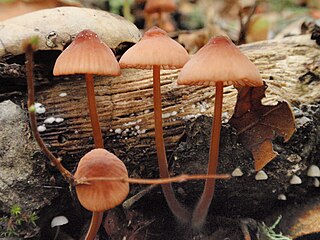
Mycena californiensis is a species of fungus in the family Mycenaceae. It is a common and abundant species in the coastal oak woodlands of California, where it grows saprobically, feeding on the fallen leaves and acorns of various oak species. First described in 1860 by Berkeley and Curtis, the species was collected four years earlier during an exploring and surveying expedition. It was subsequently considered a doubtful species by later Mycena researchers, until a 1999 publication validated the taxon. Mycena elegantula is considered a synonym.

Roridomyces is a genus of fungi in the family Mycenaceae. The genus, widely distributed in temperate areas, was circumscribed by Karl-Heinz Rexer in his 1994 doctoral thesis. Species in the genus were formerly placed in Mycena section Roridae. They are characterized by having a slimy, glutinous stipe in moist conditions.
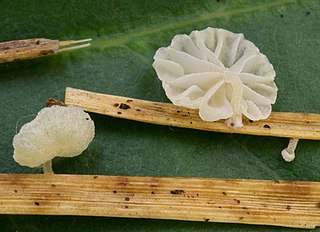
Resinomycena is a genus of fungi in the mushroom family Mycenaceae. The genus contains at least eight species found in North America, Europe and eastern Asia. This genus of small white to tan colored agarics is saprophytic and colonizes leaf litter, bark, small twigs and decaying monocot vegetation. The fruitbodies are small and resemble Mycena or Marasmius or Hemimycena and are distinguished by amyloid spores, poorly dextrinoid tissues, and the abundant oily, resinous cystidia on the pileus, lamellae edges and stipes. One recently described species, Resinomycena fulgens from Japan that is a synonym of Resinomycena japonica, has luminescent fruitbodies.

Leucocoprinus fragilissimus, commonly known as the fragile dapperling, is a species of gilled mushroom in the family Agaricaceae.
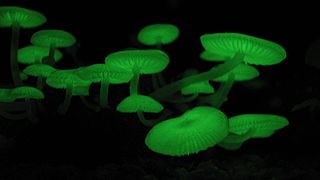
Mycena chlorophos is a species of agaric fungus in the family Mycenaceae. First described in 1860, the fungus is found in subtropical Asia, including India, Japan, Taiwan, Polynesia, Indonesia, and Sri Lanka, in Australia, and Brazil. Fruit bodies (mushrooms) have pale brownish-grey sticky caps up to 30 mm (1.2 in) in diameter atop stems 6–30 mm (0.2–1.2 in) long and up to a millimeter thick. The mushrooms are bioluminescent and emit a pale green light. Fruiting occurs in forests on fallen woody debris such as dead twigs, branches, and logs. The fungus can be made to grow and fruit in laboratory conditions, and the growth conditions affecting bioluminescence have been investigated.
Roridomyces irritans is a species of fungus in the genus Roridomyces, family Mycenaceae. Originally described from New Caledonia as Mycena irritans by Egon Horak in 1978, the species was transferred to Roridomyces in 1994. The fruit bodies are bioluminescent.

Roridomyces austrororidus, commonly known as the austro dripping bonnet, is a species of agaric fungus in the family Mycenaceae. Described as new to science in 1962 by American mycologist Rolf Singer, it is found in South America, New Zealand, and Australia, where it grows on rotting wood.
Roridomyces appendiculatus is a species of fungus in the genus Roridomyces, family Mycenaceae. It is found in Europe.

Lentinula lateritia is a species of agaric fungus in the family Omphalotaceae. It is found in South-east Asia and Australasia, except for New Zealand. Originally described by Miles Joseph Berkeley in 1881 as a species of Agaricus, it was transferred to the genus Lentinula in 1983 by David Pegler.
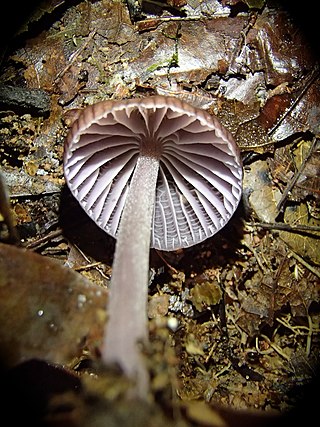
Mycena holoporphyra is a species of agaric fungus in the family Mycenaceae. It was first described by Miles Joseph Berkeley and Moses Ashley Curtis in 1868 as Agaricus holoporphyrus. Rolf Singer transferred it to the genus Mycena in 1962, where it is classified in the section Calodontes. First described from Cuba, it is also found in Trinidad, Africa, Mexico, and Central America and South America.Nicolas Niveirio, Orlando F. Popoff, and Edgardo O. Alberto, classify Mycena Holoporphyra for their distinguishable basiodiocarps that are violet or purple, having a radish like smell, fungal tissues, and a lack of pleurocystidia. In addition, Pegler, describes the species as having a pale cream spore print with spores of ellipse cylindrical to oblong cylindric, hyaline and deeply amyloid.
Roridomyces praeclarus is a species of fungus in the genus Roridomyces, family Mycenaceae.
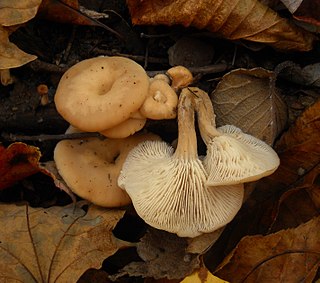
Lentinellus micheneri is a species of wood-inhabiting fungus in the family Auriscalpiaceae. It was first described in 1853 by mycologist Miles Berkeley and Moses Ashley Curtis as Lentinus micheneri. David Pegler transferred it to the genus Lentinellus in 1983. Like all species in its genus, it is inedible.

Pleurotus albidus is a species of edible fungus in the family Pleurotaceae. Found in Caribbean, Central America and South America, it was described as new to science by Miles Joseph Berkeley, and given its current name by David Norman Pegler in 1983. It grows on trees such as Salix humboldtiana, other willows, Populus and Araucaria angustifolia, and can be cultivated by humans. Phylogenetic research has shown that while it belongs to P. ostreatus clade, it forms its own intersterility group.

Lentinus levis is a species of edible fungus in the family Polyporaceae. It was described by Miles Joseph Berkeley and Moses Ashley Curtis in 1853 and given its current name in 1915 by William Murrill. As a saprotroph, it can be cultivated. In nature it grows in subtropical to tropical climate. It is recognized and sometimes collected as a food by Huichol people of Mexico, although they prefer eating other, less chewy mushrooms. For a long time thought to be a member of Pleurotus genus, it has been moved to genus Lentinus.












